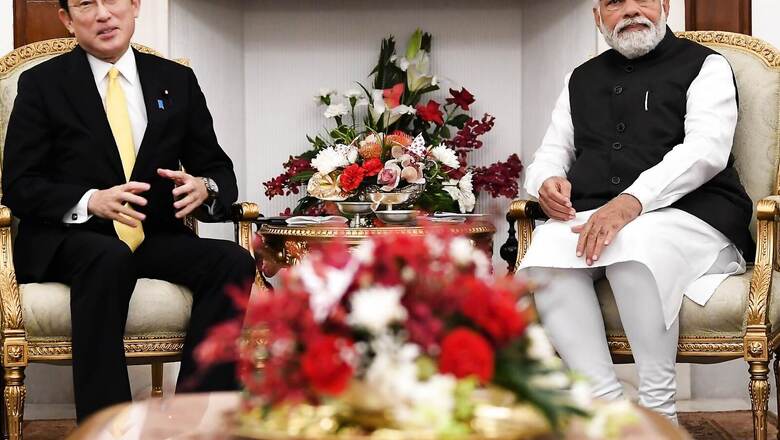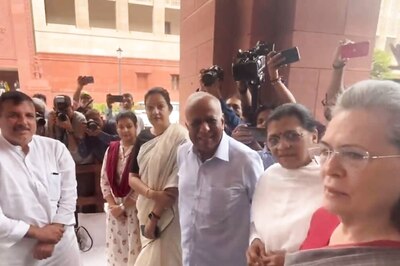
views
Annual summits between India and Japan which had been interrupted by the COVID pandemic have resumed with the visit, albeit short, of Japanese Prime Minister Fumio Kishida to India (March 19-20). Prime Minister Narendra Modi noted Kishida has been to India before in his capacity as Japan’s Foreign Minister and is therefore familiar with the various dimensions of our ties. His visit has come at a moment when the Western alliance and Russia are on a collision course that is shaking the foundations of the existing global system already under challenge by China.
Modi was right in remarking at the joint press conference that the summit had taken place when the world is still grappling with the effects of the COVID-19 pandemic, global economic recovery is being hampered and geo-political events are also presenting new challenges – a reference no doubt to the conflict in Ukraine pitting the West against Russia. These developments do require deeper cooperation and understanding between India and Japan.
Already under the aegis of Quad, India and Japan are collaborating on a programme to produce anti-COVID vaccine in India for the Indo-Pacific region. This programme should not lose momentum even if the pandemic has ebbed for the moment. The prospects of global economic recovery post-COVID is suddenly in jeopardy because of the Ukraine crisis; the resulting disruptions in supply chains in many areas and the consequences of the draconian sanctions imposed by the West on Russia which have had a dramatic effect, for instance, on oil prices that affect major oil importing countries like India and Japan.
On the Ukrainian crisis, India and Japan need to knit understandings that are not tied to the perspectives of the US and the G7. The European theatre is not the core one for India and Japan for their security. Nato expansion and Russian opposition to it are not central to global security either. The heavy price of the failure of the West and Russia to together develop an equitable European security architecture should not be imposed on the rest of the world. The need of the hour is to end the violence, put a ceasefire in place and promote a negotiated solution rather than fuel the conflict further by supplying lethal arms and political encouragement to the Ukrainian regime.
Ukraine Crisis and Russia-China Ties
Ukraine was discussed between the two principals. The Japanese briefings, no doubt with the US in mind, have made it appear that the subject was the focal point of discussions. The objective of the exchanges should not have been to have a united front on the issue but to understand the implications for the Indo-Pacific and the Quad. A united front is not a realistic proposition because Japan is allied to the US whereas India is not, and the ties of the two countries with Russia are qualitatively different. Japan has unresolved territorial differences with Russia dating to the Second World War while India’s ties with Russia have been traditionally close.
What should be of concern to both countries are the developing strategic ties between Russia and China, set to strengthen further as a result of the Ukraine conflict engendering enormous across-the-board pressure on Russia by the West. Russia and China are already engaged in joint maritime activity in the vicinity of Japan and oppose the Quad and the Indo-Pacific concept, seen by them as a US-led effort to establish blocs and security arrangements excluding China.
The Ukraine issue is not likely to be easily settled. Neither the West nor Russia will accept a seeming defeat in achieving their respective objectives. The US, whatever it might say, does not have the capacity to simultaneously confront both Russia at one end of Eurasia and China at the other end. President Biden’s outreach to President Xi, as per the Chinese read-out, should be disquieting for both Japan and India in the pacifying assurances he gives about not seeking to create any alliance against China or seek a conflict with it. The White House read-out contains a veiled threat to China not to back Russia in this conflict under the pain of sanctions. If such sanctions are imposed on China, Japan has to make an assessment of their impact on its economic interests in China.
India and Japan have to develop a joint strategy to minimise the risks that are emerging. (In this context, Japanese exhortations to us during the visit to join the Regional Comprehensive Economic Partnership and how joint investments by India and Japan in India or in third countries for export to the RCEP countries will be hampered by the clause on Rules of Origin shows the conflict in Japan between its economic and security interests vis a vis China, which India has to be conscious of in policymaking). With their own stakes in the Indo-Pacific region, the two countries also need to think independently of US policies that are also dictated by domestic political pressures. India in the Quad stabilises its agenda and geo-political direction. India’s presence in it may displease Russia but its opposition to it under China’s impulsion is kept relatively contained.
Efforts to put Ukraine on the Quad agenda are not desirable. The genesis of Quad and its agenda have nothing to do with the security issues in the European theatre. Japan and Australia, as US allies, can support the US position outside the Quad format. Doing within it will only give ammunition to Chinese propaganda, already evident in the latest statements made by a Chinese Vice-Foreign Minister, that Quad is an Asian Nato in the making.
In the joint statement, India has not gone beyond its stated position in the UN Security Council, with principled reference to the UN Charter, international law and respect for sovereignty and territorial integrity of states, immediate cessation of violence and return to the path of dialogue and diplomacy for resolution of the conflict, as well as appropriate steps to address the humanitarian crisis in Ukraine.
Robust Language of Joint Statement
The language in the joint statement on the Indo-Pacific is robust. The importance of bilateral and plurilateral partnerships there is underlined and the implementation of the Quad’s positive agenda to be advanced at the next Quad Leaders’ Summit in Japan in the coming months is affirmed. The importance of non-militarisation (US Indo-Pacific Command Chief says China has fully militarised three South China Sea islands) and self-restraint, and the early conclusion of a substantive and effective Code of Conduct in the South China Sea in accordance with international law, especially UNCLOS, without prejudice to the rights and interests of all nations including those not party to these negotiations is underlined.
In the area of defence, positive developments such as the operationalising of the logistics agreement, bilateral and multilateral exercises including “Dharma Guardian" and “Malabar" respectively, as well as Japan’s participation for the first time in exercise MILAN have been noted, as well as the inaugural fighter exercise between the two air forces and the ongoing collaboration in the area of unmanned ground vehicle (UGV) and robotics. The 2+2 meeting will be scheduled at an early date. Defence cooperation will, however, remain limited in view of the constraints imposed on Japan by its constitution.
On terrorism, the language is robust too, responding fully to India’s concerns. It calls upon all countries to work together for rooting out terrorist safe havens and infrastructure, disrupting terrorist networks and their financing channels, and halting cross-border movement of terrorists. Importantly, it calls upon Pakistan by name to take resolute and irreversible action against terrorist networks operating out of its territory and comply fully with international commitments including to Financial Action Task Force or FATF.
Interestingly, the two countries have resolved to continue to work closely together for an early reform of the UNSC and accelerate the process, including through the commencement of text-based negotiations in the Inter-Governmental Negotiations (IGN) with an overall objective to achieve concrete outcomes in a fixed timeframe, even if this is unlikely to happen. Oddly though, in deference to Japan’s outdated non-proliferation fixations, and Kishida’s links to Hiroshima, the joint statement refers to a shared commitment to the total elimination of nuclear weapons, with Kishida stressing the importance of early entry into force of the Comprehensive Nuclear-Test-Ban Treaty (CTBT) and early conclusion of negotiations on a Fissile Material Cut-off Treaty (FMCT).
India and Japan have launched an India-Japan Clean Energy Partnership (CEP) to address climate change and ensuring energy security in areas such as electric vehicles (EV), storage systems including batteries, electric vehicle charging infrastructure (EVCI), solar energy, clean energy including green hydrogen/ammonia, wind energy, etc.
On bilateral economic cooperation, the two sides have expressed satisfaction that the investment target of JPY 3.5 trillion announced in 2014 has been achieved. They now intend to realise JPY 5 trillion ($42 billion) of public and private investment and financing from Japan to India in the next five years. This is to finance appropriate public and private projects of mutual interest. Pacts on loans to the tune of Rs 20,400 crore for projects in various domains were signed. At the business meeting, Modi mentioned the 9,000 projects worth $1.58 trillion providing many opportunities for Japanese companies. To promote trade and investment, the delayed review of the implementation of CEPA (Comprehensive Economic Partnership Agreement) through existing mechanisms has been mentioned, though Japan seems to be dragging its feet on this.
The India-Japan Digital Partnership with joint projects for digital transformation, support to provide opportunities for Indian IT professionals to work in Japan and Japanese companies, and collaboration in the area of IoT, AI and other emerging technologies is potentially very important. Kishida is favourably disposed to attracting more highly skilled Indian IT professionals to contribute to the Japanese ICT sector. The “India-Japan fund-of-funds" will mobilise funds for emerging Indian start-ups. Memorandum of Cooperation in the fields of cybersecurity and ICT, and further cooperation in various fields like 5G, open RAN, telecom network security, submarine cable systems, and quantum communications are on the agenda.
The two sides are collaborating through the Act East Forum (AEF) for sustainable economic development of India’s North Eastern Region and for enhancing the region’s connectivity with Southeast Asia, currently stalled by the situation in Myanmar. The launch of the “India-Japan Initiative for Sustainable Development of the North Eastern Region of India", which includes cooperation in health care, forest resources management, connectivity and tourism in different states of the North Eastern Region, is to be welcomed. Strengthening cooperation in the area of skill development is high on the bilateral agenda.
All in all, a productive visit at a time when the so-called international order is being shaken by the Ukraine war and the highly disruptive sanctions imposed by the West and Japan on Russia. How all this affects the Indo-Pacific region and redounds to China’s advantage will be seen in due course.
Kanwal Sibal is the former Indian Foreign Secretary. He was India’s Ambassador to Turkey, Egypt, France and Russia. The views expressed in this article are those of the author and do not represent the stand of this publication.
Read all the Latest Opinion News and Breaking News here



















Comments
0 comment